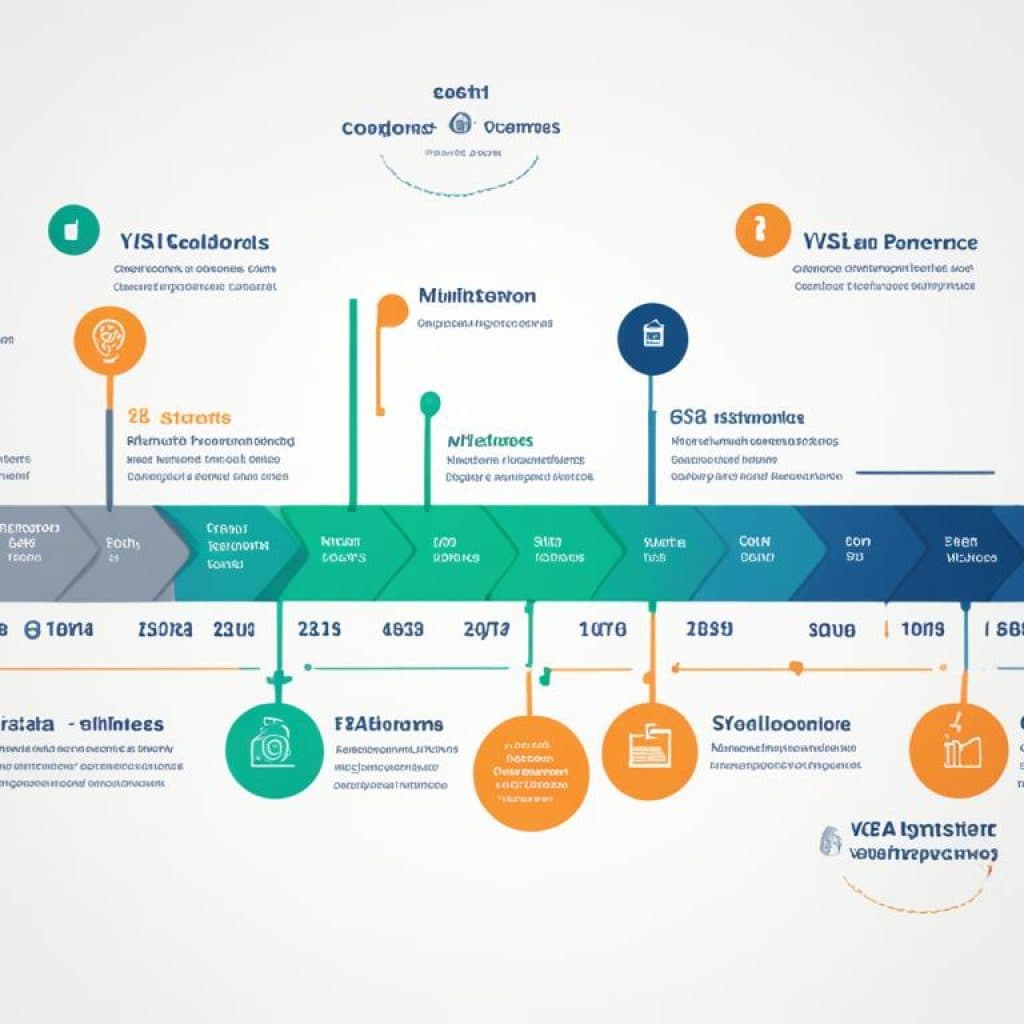Are you engaged to a U.S. citizen and dreaming of starting your life together in the United States? The K1 visa might just be the key to turning your dreams into reality. But what exactly is a K1 visa, and what does it entail? In this article, we will delve into the essentials of the K1 visa process, requirements, timeline, and cost, providing you with all the information you need to navigate this unique pathway to your future in the U.S.
Key Takeaways:
- Discover what a K1 visa is and how it can bring you closer to your American dream.
- Understand the requirements you must meet as an engaged couple.
- Explore the step-by-step process of obtaining a K1 visa.
- Uncover the timeline and costs associated with the K1 visa application.
- Gain insights into the documents needed and the visa interview process.
What is a K1 Visa?
A K1 Visa, also known as the Fiancé(e) Visa, is a non-immigrant visa specifically designed for foreign nationals who are engaged to U.S. citizens and intend to marry within 90 days of entering the United States. Its primary purpose is to allow the foreign fiancé(e) to enter the U.S. to marry and eventually apply for permanent residency.
K1 Visa Requirements
To be eligible for a K1 Visa, the couple must meet certain requirements. These requirements are put in place to ensure that the relationship is genuine and that both partners are legally eligible to marry.
- U.S. Citizenship: The sponsoring fiancé must be a U.S. citizen.
- Legally Free to Marry: Both partners must be legally free to marry, meaning they are not currently married to someone else.
- Meeting in Person: The couple must have met in person within the two years prior to filing the visa application. This requirement aims to establish the authenticity of the relationship.
In addition to these primary requirements, there are a few more criteria that must be met:
- Intention to Marry: Both partners must have a genuine intention to marry within 90 days of the foreign fiancé(e) entering the United States.
- Financial Requirements: The U.S. citizen sponsor must meet certain income requirements to prove financial ability to support the foreign fiancé(e) upon their arrival in the U.S.
Meeting these requirements is crucial to ensure a successful K1 Visa application. In the next section, we will explore the step-by-step process of obtaining a K1 Visa.
K1 Visa Requirements Summary:
| Requirements | Description |
|---|---|
| U.S. Citizenship | The sponsoring fiancé must be a U.S. citizen. |
| Legally Free to Marry | Both partners must be legally free to marry. |
| Meeting in Person | The couple must have met in person within the two years prior to filing the visa application. |
| Intention to Marry | Both partners must have a genuine intention to marry within 90 days of the foreign fiancé(e) entering the United States. |
| Financial Requirements | The U.S. citizen sponsor must meet certain income requirements to support the foreign fiancé(e) upon their arrival in the U.S. |
K1 Visa Process
The K1 visa process involves several steps that must be followed to successfully obtain a K1 visa. Here is an overview of the process:
- Step 1: File Form I-129F
The first step in the K1 visa process is for the U.S. citizen sponsor to file Form I-129F, also known as the “Petition for Alien Fiancé(e)”, with the U.S. Citizenship and Immigration Services (USCIS). This form establishes the petitioner’s relationship with the foreign fiancé(e) and initiates the visa application process.
- Approval and Forwarding
Once the Form I-129F is approved by USCIS, it is sent to the U.S. Department of State’s National Visa Center (NVC) for further processing. The NVC will then forward the approved petition to the U.S. embassy or consulate in the foreign fiancé(e)’s home country.
- Complete DS-160 Form
After receiving the approved petition, the foreign fiancé(e) must complete the DS-160 form, also known as the “Online Nonimmigrant Visa Application”. This form collects biographical information and other details required for the visa application.
- Attend Visa Interview
Once the DS-160 form is completed, the foreign fiancé(e) will need to schedule and attend a visa interview at the U.S. embassy or consulate in their home country. During the interview, the consular officer will assess the authenticity of the relationship and determine if the foreign fiancé(e) meets the eligibility criteria for the K1 visa.
- Travel to the U.S. and Marry
If the visa application is approved, the foreign fiancé(e) will receive the K1 visa and can travel to the U.S. Once in the U.S., the couple has 90 days to marry the U.S. citizen sponsor. It is important to note that the marriage must take place within this 90-day period to maintain K1 visa status.
K1 Visa Timeline
The K1 visa process can be an exciting journey for couples, but it’s crucial to understand the timeline involved. While processing times can vary depending on several factors, including USCIS processing times, embassy workload, and individual circumstances, the average timeline for a K1 visa is approximately six months from the filing of the petition to the approval and issuance of the visa.
Throughout the process, patience and proper planning are key to ensure a smooth and successful outcome. Here is a breakdown of the K1 visa timeline:
- Filing the petition: The first step is for the U.S. citizen sponsor to file Form I-129F (“Petition for Alien Fiancé(e)”) with USCIS. This typically takes several weeks or months for processing.
- USCIS approval: Once the petition is approved by USCIS, it is forwarded to the U.S. Department of State for further processing.
- NVC processing: The National Visa Center (NVC) will review the approved petition and assign a case number. They will then forward the case to the U.S. embassy or consulate in the foreign fiancé(e)’s country.
- Visa interview scheduling: The U.S. embassy or consulate will schedule a visa interview for the foreign fiancé(e) once they receive the case from the NVC. The interview appointment can take several weeks to months to be scheduled.
- Visa interview: At the visa interview, the foreign fiancé(e) will be required to provide the necessary documents and undergo an interview with a consular officer. This step is crucial in determining the visa’s approval.
- Visa issuance: If the visa is approved, the foreign fiancé(e) will receive the K1 visa in their passport. This process can take a few days to a couple of weeks.
It’s important to note that the timeline provided is an average estimate, and actual processing times may vary. Factors such as high embassy workload, additional administrative processing, or delays in document submission can affect the overall timeline.
Being well-prepared, organized, and proactive throughout the process can help minimize delays and ensure a smoother K1 visa timeline experience. Regularly communicating with USCIS, the NVC, and the U.S. embassy or consulate can provide updates on the progress of the case and help address any issues that may arise.
Remember, each couple’s situation is unique, and it’s essential to consult with an immigration attorney or engage professional assistance to navigate the K1 visa process effectively.

K1 Visa Cost
When applying for a K1 visa, it’s essential to understand the associated costs. The total cost for a K1 visa is $800, which includes the filing fee for Form I-129F. However, there are additional costs that applicants should consider.
One possible additional cost is the medical exam, which is required as part of the visa application process. The cost of the medical exam can vary depending on the country and the healthcare provider, but it typically ranges from $100 to $500.
Another cost to factor in is the visa application fee, which is paid directly to the U.S. embassy or consulate during the visa interview. As of [Current Year], the K1 visa application fee is $265.
It’s important to review the specific instructions provided by the embassy or consulate in your country of residence, as payment methods and additional costs may vary. The embassy or consulate will provide guidance on how to submit the required fees and any other applicable charges.
Tip: It’s crucial to plan and budget for all the necessary expenses when applying for a K1 visa. Make sure to account for the filing fee, medical exam costs, and the visa application fee to avoid any financial surprises along the way.
Summary of K1 Visa Costs
| Cost | Description |
|---|---|
| $800 | Filing fee for Form I-129F |
| Approximately $100 – $500 | Medical exam fee |
| $265 | Visa application fee |
K1 Visa Documents
When applying for a K1 visa, it is important to gather and submit various documents to support your application. These documents serve as evidence of your eligibility and help establish the authenticity of your relationship. Here are the key documents you will need:
- Form I-129F: This is the official petition form that must be filed by the U.S. citizen sponsor with U.S. Citizenship and Immigration Services (USCIS). It establishes the intention to marry and initiates the K1 visa process.
- Proof of U.S. Citizenship: You will need to provide proof of your U.S. citizenship, such as a copy of your birth certificate, passport, or naturalization certificate.
- Proof of the Relationship: It is crucial to provide evidence that demonstrates the authenticity of your relationship. This may include photographs together, letters or emails exchanged, phone call records, and other relevant documents.
- Evidence of Meeting in Person: To meet the K1 visa requirements, you must prove that you have met your fiancé(e) in person within the two years prior to filing the visa application. This can be substantiated through travel itineraries, plane tickets, hotel receipts, or other documentation.
- Signed Statements of Intention to Marry: Both you and your fiancé(e) will need to provide signed statements confirming your intention to marry within 90 days of your fiancé(e) entering the United States on a K1 visa.
- Passport-Style Photos: You will need to submit recent passport-style photographs of yourself and your fiancé(e) with your visa application.
Additionally, you may be required to provide additional documents for the visa interview and medical examination process. It is important to carefully review the specific requirements provided by the U.S. embassy or consulate in your fiancé(e)’s home country.
Preparing and organizing all the required documents in advance can help streamline the K1 visa application process and increase your chances of a successful outcome.
K1 Visa Interview
The K1 visa interview is a crucial step in the process of obtaining a K1 visa. This interview takes place at the U.S. embassy or consulate in the foreign fiancé(e)’s home country. During the interview, an officer will review the documentation provided by the couple and ask questions to determine the authenticity of their relationship and their eligibility for the visa.
It’s important to be well-prepared for the K1 visa interview to increase the chances of a successful outcome. Here are some tips to help you navigate the interview process:
- Gather all required documents: Make sure you have all the necessary documents for the interview. This includes the completed visa application, passport, medical examination results, proof of financial support, and evidence of the relationship.
- Be organized: Keep all the documents neatly organized and easily accessible. This will help you locate them quickly during the interview and present them to the officer when requested.
- Dress appropriately: Dress professionally for the interview. This demonstrates respect for the process and presents a positive impression to the interviewing officer.
- Be honest: Answer all questions truthfully and avoid providing false information. Honesty is essential during the interview, and any inconsistencies or discrepancies may lead to a denial of the visa.
- Practice potential questions: Prepare for the interview by practicing potential questions with your fiancé(e). This will help you feel more confident and ready to answer questions about your relationship, wedding plans, and future together.
“Being well-prepared and confident during the K1 visa interview can significantly increase your chances of approval.”
Remember, the goal of the K1 visa interview is to assess the authenticity of your relationship and determine if you meet the requirements for the visa. By following these tips and thoroughly preparing for the interview, you can navigate this important step with confidence.

| Key Tips for K1 Visa Interview |
|---|
| 1. Gather all required documents |
| 2. Be organized |
| 3. Dress appropriately |
| 4. Be honest |
| 5. Practice potential questions |
K1 Visa Denial Rate
When applying for a K1 visa, it’s essential to be aware of the potential for denial. The denial rate for K1 visas is approximately 19.7%. This means that out of the total number of Form I-129F applications received, around 9,492 were denied in FY 2022.
However, don’t let this discourage you. By carefully following all the requirements and providing sufficient evidence to support your case, you can increase your chances of approval.
Here are some key factors to consider to minimize the risk of denial:
- Thoroughly review the eligibility requirements: Ensure that you and your fiancé(e) meet all the necessary criteria, including being legally free to marry and having met in person within the two years prior to filing the application.
- Strong evidence of the authenticity of your relationship: Include documentation that demonstrates the genuineness of your relationship, such as photographs, travel itineraries, and shared financial responsibilities.
- Clear intention to marry within 90 days: Provide a signed statement expressing your commitment to getting married within the required timeframe.
- Meet the income requirements: Ensure that the U.S. citizen sponsor meets the necessary income threshold to financially support the foreign fiancé(e) upon their arrival in the U.S.
“Remember, a denial does not necessarily mean the end of your journey. You may have the option to appeal the decision or reapply with additional evidence addressing the concerns raised.”
By carefully preparing your application, addressing any potential red flags, and presenting a comprehensive case, you can increase your chances of a successful K1 visa approval.
| Year | Applications Received | Denial Rate |
|---|---|---|
| FY 2022 | 48,072 | 19.7% |
K1 Visa Cost Breakdown
Understanding the cost breakdown of a K1 visa is crucial when planning to bring your fiancé(e) to the United States. Let’s take a closer look at the expenses involved:
Filing Fee for Form I-129F:
The filing fee for Form I-129F, the petition for an alien fiancé(e), is $800. This fee is non-refundable and covers the processing of your petition by U.S. Citizenship and Immigration Services (USCIS). It is important to note that this fee is subject to change, so it’s essential to check the latest fee schedule.
Medical Exam:
In addition to the filing fee, your fiancé(e) will need to undergo a medical examination as part of the K1 visa application process. The cost of this exam typically ranges around $200. It’s essential to select a designated Civil Surgeon authorized by USCIS to ensure compliance with all medical requirements.
Visa Application Fee:
Once the petition is approved and forwarded to the U.S. Department of State, your fiancé(e) will be required to pay a visa application fee. The current fee for a K1 visa application is $265. This fee is payable at the U.S. embassy or consulate during the visa interview process.
Keep in mind that the total cost for a K1 visa can vary depending on additional expenses such as translating documents, obtaining required certificates, and any travel expenses incurred during the application process. It’s essential to budget for these costs and plan accordingly.
| Expense | Cost |
|---|---|
| Filing Fee for Form I-129F | $800 |
| Medical Exam | $200 (approximately) |
| Visa Application Fee | $265 |
Please note that the above costs are based on current information and may be subject to change. It’s recommended to consult the official USCIS and U.S. Department of State websites for the most up-to-date fee schedules and requirements.
With a clear understanding of the K1 visa cost breakdown, you can better plan your finances and ensure a smooth application process for your fiancé(e) to join you in the United States.
K1 Visa Waiver of the 2-Year Rule
The K1 visa application process requires couples to provide evidence that they have met in person at least once within the two years prior to filing the application. However, there are circumstances where meeting this requirement may not be feasible or may cause significant hardship to the foreign fiancé(e). In such cases, couples can request a waiver of the 2-year rule.
A waiver of the 2-year rule can be sought if meeting in person would conflict with religious or cultural traditions or if it would result in severe hardship for the foreign fiancé(e). The waiver request must be submitted along with the Form I-129F, which is the petition for the K1 visa.
When requesting a waiver, it is crucial to provide strong evidence supporting the difficulty in arranging the in-person meeting. This can include documentation of cultural or religious practices that prohibit meeting before marriage, or evidence of financial or medical hardships that would make traveling impossible.
“Seeking a waiver of the 2-year rule can be a viable option for couples who face genuine challenges in meeting the requirement,” says immigration attorney Jane Smith. “It’s important to thoroughly document and explain the reasons for requesting the waiver, and provide compelling evidence of the hardship or conflict involved.”
The decision to grant a waiver is at the discretion of the U.S. Citizenship and Immigration Services (USCIS). They will carefully review the waiver request and supporting evidence before making a decision.
It’s essential for couples considering a waiver to consult with an experienced immigration attorney who can guide them through the process and help present a compelling case for the waiver.

Getting Married on a K1 Visa
Once the foreign fiancé(e) enters the U.S. on a K1 visa, the couple has 90 days to get married. It’s important to plan and prepare for the wedding within this timeframe. Failure to get married within 90 days may result in the loss of K1 visa status.
Tips for Getting Married on a K1 Visa
Planning a wedding can be stressful, but with proper preparation, getting married on a K1 visa can be a smooth process. Here are some tips to help you along the way:
- Start early: Begin planning your wedding as soon as possible after the foreign fiancé(e) arrives in the U.S. This will allow you to secure a venue, book vendors, and take care of other essential arrangements.
- Obtain necessary documents: Ensure that you have all the required documents for your marriage, such as marriage licenses and certificates. Check with your local county clerk’s office for specific requirements.
- Invite witnesses: Most states require witnesses for the marriage ceremony. Make sure to arrange for witnesses to be present on the wedding day.
- Consider cultural traditions: Incorporate your cultural traditions into the wedding ceremony, making it a meaningful and memorable experience for both you and your partner.
- Budget carefully: Plan your wedding budget wisely, taking into account the costs of the ceremony, reception, and any additional expenses. Stick to your budget to avoid financial stress.
- Inform your guests: Let your family and friends know about your wedding plans well in advance, especially if they need to travel to attend the ceremony. Send out invitations or save-the-date cards to ensure everyone can be there to celebrate with you.
- Enjoy the process: Remember that your wedding day is a celebration of your love and commitment to each other. Take the time to enjoy the planning process and make lasting memories with your partner.
By following these tips and staying organized, you can have a beautiful wedding on a K1 visa and begin your journey towards building a life together in the United States.
Adjusting Status from K1 Visa to Green Card
After getting married on a K1 visa, the next crucial step for couples is to adjust their status from a temporary non-immigrant visa to a lawful permanent resident in the United States. This process involves filing Form I-485, also known as the Application to Register Permanent Residence or Adjust Status, with U.S. Citizenship and Immigration Services (USCIS).
Adjusting status to a green card allows the foreign spouse to obtain lawful permanent residency and enjoy the benefits and privileges that come with it, including the right to live and work in the U.S. without any time restrictions.
To ensure a successful transition and approval of the green card application, it’s crucial to follow the guidelines and requirements set by USCIS. This includes submitting the necessary supporting documents, completing the application accurately, and paying the applicable fees.
Required Documents for Adjusting Status
The following documents are typically required when applying for adjustment of status:
- Form I-485, completed and signed.
- Proof of legal entry into the United States.
- Affidavit of Support (Form I-864) from the sponsoring spouse.
- Proof of the marriage, including the marriage certificate.
- Proof of the sponsoring spouse’s U.S. citizenship or permanent residency status.
- Photographs as per USCIS specifications.
| Document | Description |
|---|---|
| Form I-485 | Application to Register Permanent Residence or Adjust Status |
| Proof of legal entry | Valid passport with visa stamps, I-94 arrival/departure record, or other relevant documentation |
| Affidavit of Support (Form I-864) | Proof of financial support from the sponsoring spouse |
| Proof of marriage | Marriage certificate, wedding photographs, joint financial documents, etc. |
| Proof of sponsoring spouse’s status | Proof of U.S. citizenship (birth certificate, passport) or permanent residency (green card) |
| Photographs | Passport-style photographs meeting USCIS specifications |
Note: Additional documentation may be required based on individual circumstances, such as divorce decrees or documentation of previous marriages. It’s essential to review the USCIS guidelines and follow any specific instructions provided.
The Adjustment of Status Process
Once the adjustment of status application is submitted to USCIS, the spouse seeking a green card may be required to attend a biometrics appointment to provide fingerprints, photographs, and a signature for background checks. Following this, USCIS will schedule an interview to further assess the eligibility for a green card.
“Adjusting status from a K1 visa to a green card is a significant milestone for couples, as it allows them to transition from temporary status to lawful permanent residence. It’s important to fully comply with the required documentation and follow the USCIS process diligently to maximize the chances of a successful outcome.”
Once the adjustment of status application is approved, the foreign spouse will receive a green card, officially granting them permanent residency in the United States. With the green card, the couple can freely live, work, and travel in the U.S., and they will eventually have the option to apply for U.S. citizenship through naturalization.
Conclusion
The K1 visa provides a unique opportunity for couples to unite in the United States and begin their journey towards permanent residency. By understanding the process, requirements, timeline, and cost of obtaining a K1 visa, couples can confidently navigate the application process and plan for their future together in the U.S.
Throughout this article, we have discussed the essential aspects of the K1 visa, including its purpose as a non-immigrant visa for engaged couples and the requirements for both sponsors and foreign fiancé(e)s. We have also explored the step-by-step process involved in obtaining a K1 visa, highlighting the importance of meticulous preparation and submitting the necessary documents.
Additionally, we have outlined the timeline and costs associated with the K1 visa application, emphasizing the need for patience and financial planning. It is crucial for couples to allocate sufficient time and resources to ensure a smooth and successful application process. Once the K1 visa is obtained, couples have 90 days to get married and proceed with their plans for permanent residency in the United States.
With a clear understanding of the K1 visa and its requirements, couples can embark on their journey with confidence, knowing that they have the knowledge and tools to navigate the process. The K1 visa opens the door to a future filled with love, opportunities, and a new chapter in their lives together in the United States.
FAQ
What is a K1 Visa?
A K1 Visa, also known as the Fiancé(e) Visa, is a non-immigrant visa specifically designed for foreign nationals who are engaged to U.S. citizens and intend to marry within 90 days of entering the United States. Its primary purpose is to allow the foreign fiancé(e) to enter the U.S. to marry and eventually apply for permanent residency.
What are the requirements for a K1 Visa?
To be eligible for a K1 Visa, the couple must meet certain requirements. The sponsoring fiancé(e) must be a U.S. citizen, both partners must be legally free to marry, and they must have met in person within the two years prior to filing the visa application. Additional requirements include proving the authenticity of the relationship, having a signed document stating their intention to marry within 90 days, and meeting the income requirements.
What is the K1 Visa process?
The K1 Visa process involves several steps. The first step is for the U.S. citizen sponsor to file Form I-129F (“Petition for Alien Fiancé(e)”) with USCIS. Once the petition is approved, it is forwarded to the U.S. Department of State, and the foreign fiancé(e) is required to complete the DS-160 form and attend an interview at the U.S. embassy or consulate in their home country. If approved, the foreign fiancé(e) can then travel to the U.S. and must marry the U.S. citizen sponsor within 90 days.
What is the timeline for a K1 Visa?
The processing time for a K1 visa can vary, but on average, it takes about 6 months from the filing of the petition to the approval and issuance of the visa. This timeline can be influenced by factors such as USCIS processing times, embassy or consulate workload, and individual circumstances.
How much does a K1 Visa cost?
The cost to apply for a K1 visa is $800, which includes the filing fee for Form I-129F. Additional costs may include the medical exam and the visa application fee. It’s important to review specific instructions regarding payment methods and additional costs that may vary by country.
What documents are required for a K1 Visa?
Various documents are required for a K1 visa application. These include Form I-129F, proof of U.S. citizenship, proof of the relationship, evidence of meeting in person, signed statements of intention to marry, and passport-style photos. Additional documents may be required for the visa interview and medical exam.
What happens during the K1 Visa interview?
The K1 visa interview takes place at the U.S. embassy or consulate in the foreign fiancé(e)’s home country. The interviewing officer will make a decision on the case based on the documentation provided and the interview. It’s important to be prepared with all the required documents and be ready to answer questions about the relationship and wedding plans.
What is the denial rate for K1 Visas?
The denial rate for K1 visas is approximately 19.7%. This means that out of the total number of Form I-129F applications received, about 9,492 were denied in FY 2022. It’s important to carefully follow all the requirements and provide sufficient evidence to increase the chances of approval.
How is the cost of a K1 Visa broken down?
The total cost for a K1 visa is $800. This includes the filing fee for Form I-129F. Additional costs may include the medical exam, which typically costs around $200, and the visa application fee of $265. It’s important to budget for these costs and consider any additional expenses, such as translating documents and obtaining required documents.
Are there any exceptions to the 2-year meeting requirement for a K1 Visa?
The 2-year rule requires couples to provide proof that they’ve met in person at least once within the two years before filing the K1 visa application. However, there are exceptions to this rule. Couples can request a waiver of the 2-year rule if meeting in person would conflict with religious or cultural traditions or would result in severe hardship to the foreign fiancé(e). The waiver request must be submitted with Form I-129F and include evidence of the difficulty in arranging the meeting.
What happens after getting married on a K1 Visa?
Once the foreign fiancé(e) enters the U.S. on a K1 visa, the couple has 90 days to get married. It’s important to plan and prepare for the wedding within this timeframe. Failure to get married within 90 days may result in the loss of K1 visa status.
How can I adjust status from a K1 Visa to a Green Card?
After getting married on a K1 visa, the next step is to apply for a marriage-based green card. This process involves filing Form I-485 to adjust status to a lawful permanent resident. It’s important to follow the guidelines and requirements for this process to ensure a successful transition to permanent residency.








Add comment